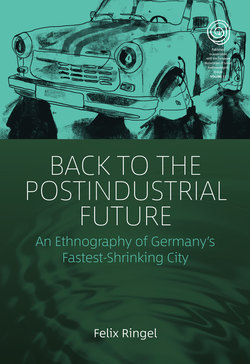Читать книгу Back to the Postindustrial Future - Felix Ringel - Страница 25
На сайте Литреса книга снята с продажи.
Social Science Contexts: Postmodernism
ОглавлениеFrom an academic point of view, several perspectives come to mind with which to approach Hoyerswerda’s problematic present. The German social science literature on East Germany, for instance, often embeds what is happening in Hoyerswerda in a narrative of failed reunification, presenting Hoyerswerda as a prime example of this ‘failure’.6 In a broader postsocialist approach too, a narrative of failed transformation could be deployed, especially since Hoyerswerda as a former socialist model city lends itself neatly to explaining why it was not prepared to catch up with the West. Such account could be used for different aims: to critique the elites in charge of the transformation or to celebrate the many local responses. With a wider temporal perspective, one could also claim that Hoyerswerda is yet another city affected by the post-Fordist changes in the dominant modes of capitalist production and distribution. Hoyerswerda could then be presented as a prime example of deindustrialization or postindustrialization and the inequality resulting from a neoliberally orchestrated form of globalized capitalism. This approach could concentrate on new flows of people and other demographic repercussions of contemporary socioeconomic changes.
On the one hand, all overarching contexts create useful insights via their potential for broader comparison and subsequent abstractions and generalizations; on the other hand, they might also prevent rather than enable a detailed analysis of local specificity. For example, postmodernism as the cultural clothing of flexible accumulation (Harvey 2000) is indeed somewhat traceable in Hoyerswerda, especially in the architectural reshaping of the city after 1990. A whole postmodern architectural axis was spread right across the former socialist city centre, which despite all plans for a better socialist future remained unfinished until the fall of state-socialism. The axis evoked a very specific historical and spatial context, that of the region of Lusatia, in order to add symbolic value to its new, and typically postmodern, entertainment-based and consumption-orientated socioeconomic foundations. Hence, the Lausitz Square was grouped with the Lausitz Center (a big shopping centre) and the renamed concert venue Lausitzhalle (the former Mine- and Energy-Workers’ Cultural House – Haus der Berg- und Energiearbeiter) lined up with the Lausitz Tower (sic; a newly renovated eleven-storey apartment house turned architectural landmark with iconic red illumination of its roof terrace) towards the Lausitz Bad (the city’s new leisure and aquatic centre). These shopping, leisure and architectural spectacles were built or renamed after 1990, and may indeed be seen as indicative of the actual postmodern forces at work and the respective changes they brought by. In their stereotypical postmodern character, they were only outdone by the never-realized plans for a Karl-May-Leisure Park, which would have used the sandy postmining areas for a Wild West amusement park in reference to Karl May’s still very popular cowboy and Native American stories around the characters of Winnetou and Old Shatterhand from the late nineteenth century.
However, the apparent impact of the global phenomenon of postmodernism would only rarely be the context of reference used in my fieldsite. Rather, my informants very specifically talked about the West German head of the post-1989 urban planning department, who left most of these postmodern traces in Hoyerswerda’s cityscape, as a ‘postmodernist’. He was repeatedly remembered as not understanding ‘Hoyerswerda’s modernist architectural spirit’. My informants also bitterly remarked that his West German architect friends realized many of his projects rather than one of the many local architects. Indeed, such invocations of the context of postmodernity are situated political attempts, embedded in the local economy of knowledge, in which different issues are at stake. If I were to impose any of the common academic contexts (such as neoliberalism, postmodernism or globalization), I might miss out on exactly these diverse local meanings and situational uses of (contextual) knowledge and specific narratives and stories. The same applies to two further predictable contexts: that of Marxism and postsocialism, which I respectively discuss in the following sections. After that, I suggest that the local context of shrinkage combines some of the advantages of other contexts and still entails new imaginaries because its main focus is not on the past, but on the future.
